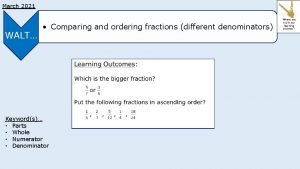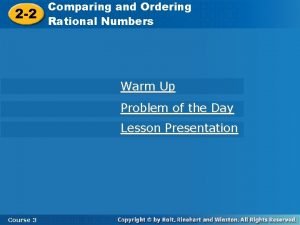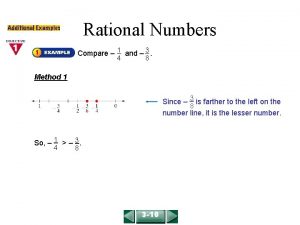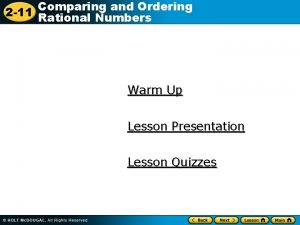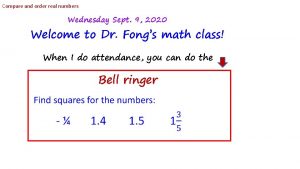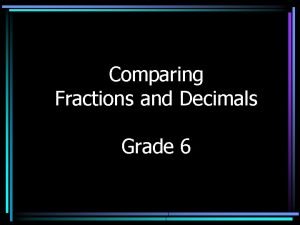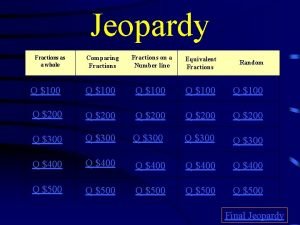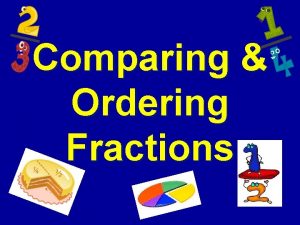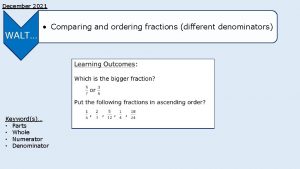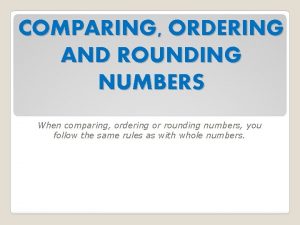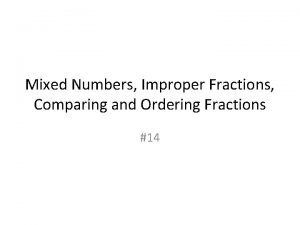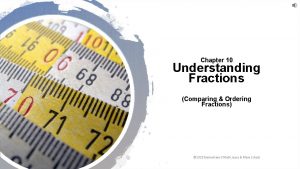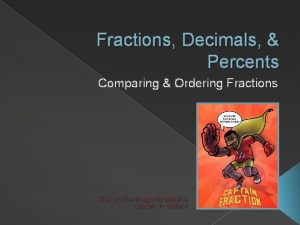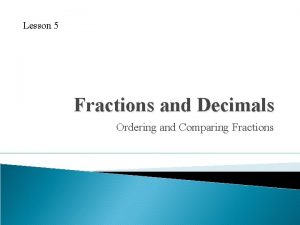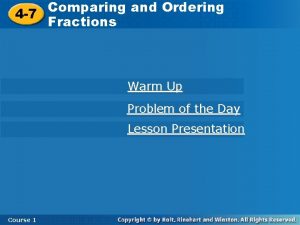March 2021 WALT Comparing and ordering fractions different


















- Slides: 18

March 2021 WALT… • Comparing and ordering fractions (different denominators) Keyword(s)… • Parts • Whole • Numerator • Denominator Where are we in our learning journey?

RECAP Compare these fractions, using <, > or = 11 20 > 3 16 > 7 16 11 18

EXPLORE Which diagram doesn’t have a pair? 2 3 4 5 3 4

QUESTION Compare these fractions, using <, > or = Can you explain why and fill in the blank? 2 6 < 5 12 5 6 > 6 8 How can we compare fractions without using a diagram?

DEFINE Fractions can be compared more easily by making the denominators the same. Find the common denominator Multiply fractions to make the denominators the same Compare the numerators. If the numerator is bigger then the fraction is bigger.

EXAMPLE Compare these fractions: 5 12 9 24 > 12 needs to be multiplied by 2 > Make denominators the same: 8 needs to be multiplied by 3 3 8 Common denominator: 8 and 12 both go into 24 10 24 Compare numerators: 10 is bigger than 9 therefore 5/12 is bigger than 3/8

EXAMPLE Compare these fractions: Make denominators the same: 9 needs to be multiplied by 2 6 needs to be multiplied by 3 8 9 > 5 6 Common denominator: 9 and 6 both go into 18 16 18 > 15 18 Compare numerators: 16 is bigger than 15 therefore 8/9 is bigger than 5/6

CHECK > 3 4 5 6 > 9 12 10 12

CHECK 3 7 > 1 3 9 21 > 7 21

EXERCISE

ANSWERS

DEFINE Fractions can also be compared by putting them in order. • Ascending means from smallest to biggest. • Descending means from biggest to smallest.

EXAMPLE Put the following fractions in ascending order: 5 8 7 12 18 24 16 24 15 24 14 24 5 8 4 6 > > 7 12 • Each fraction needs to then be converted so that all the denominators are the same. • The numerators can then be compared. > 4 6 3 4 • The common denominator is 24. 3 4

EXAMPLE Put the following fractions in descending order: 1 6 3 18 1 3 1 1 18 2 9 6 18 19 18 4 18 1 3 2 9 1 1 18 > > • The common denominator is 18. • Each fraction needs to then be converted so that all the denominators are the same. • The numerators can then be compared. > 1 6

EXERCISE Put the following fractions in ascending order:

ANSWERS

EXIT TICKET Put the following fractions in descending order: 13 16 19 24 10 12 4 6 6 8 39 48 38 48 40 48 32 48 36 48 19 24 6 8 4 6 10 12 > 13 16 > > >

REFLECTION What have you learnt today? . I don’t understand • • • I need more practice! I fully understand What Went Well? Even Better If? Think about how you can improve your learning
 Comparing and ordering fractions examples
Comparing and ordering fractions examples Comparing fractions with different denominators
Comparing fractions with different denominators Representing comparing and ordering decimals
Representing comparing and ordering decimals Comparing and ordering integers
Comparing and ordering integers Ordering rational numbers
Ordering rational numbers Lesson 3-3 comparing and ordering rational numbers
Lesson 3-3 comparing and ordering rational numbers Lesson 3-3 comparing and ordering rational numbers
Lesson 3-3 comparing and ordering rational numbers How do you compare real numbers
How do you compare real numbers Comparing and ordering integers
Comparing and ordering integers Ordering fractions and decimals
Ordering fractions and decimals Ordering fractions decimals and percentages
Ordering fractions decimals and percentages Ordering fractions and decimals
Ordering fractions and decimals Anthem of poland
Anthem of poland Lesson 6 compare and order fractions
Lesson 6 compare and order fractions Fractions jeopardy
Fractions jeopardy Expand the quotient by partial fractions.
Expand the quotient by partial fractions. Define comparing fractions
Define comparing fractions Weekly current events quiz
Weekly current events quiz March 5 2021
March 5 2021

